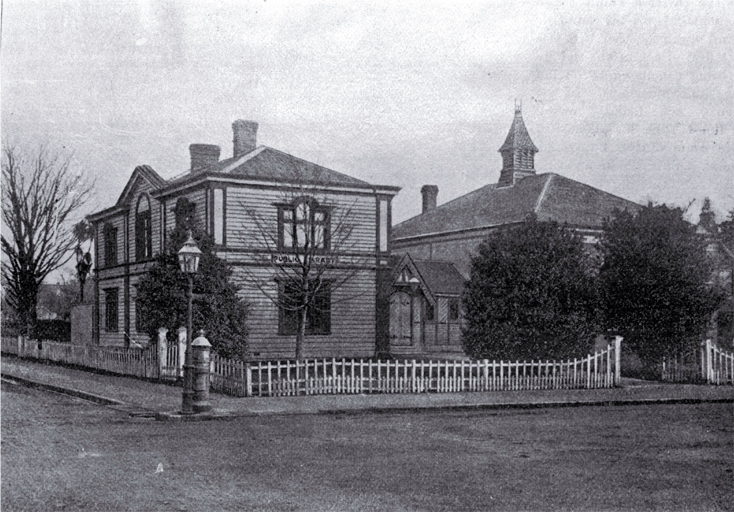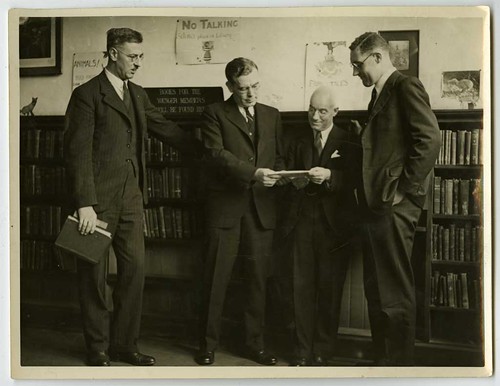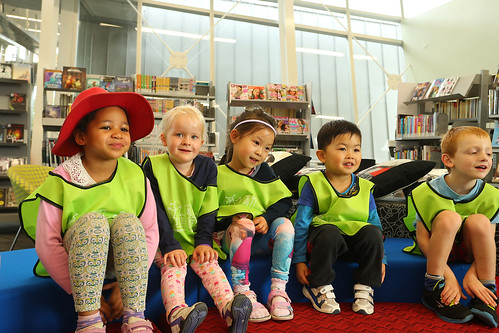Christchurch City Libraries has grown from a single room opened at the city’s Mechanics Institute in 1859 to today’s network including a mobile library and a digital library. The library’s early customers were focused on reading for self-improvement and education. As the library grew, custodianship was handed to Canterbury College, forerunner of the University of Canterbury. Under the College’s care, the library moved towards becoming a modern public library system.
Librarian Ernest Bell played a pivotal role in ensuring the ongoing success of the library by reorganising and widening the scope of its collections, improving the building and publicising libraries and reading in the community. In 1948, responsibility for the library was transferred to Christchurch City Council on behalf of the people of the city.
The Council inherited a central city library supporting a small number of suburban volunteer libraries. Today’s library network offers professionally staffed, modern buildings, the latest resources and technology, as well as a comprehensive range of online services accessible from home. Unlike library customers for generations before them, no longer do today’s customers even have to visit a library building to visit the library – but most still do.
The early years

In 1901, the original wooden building was replaced by the brick building. The Mechanics Institute struggled to maintain its financial position and was forced to hand over to the Provincial government in 1873. The collection had grown to 5,000 volumes and was managed by Canterbury College (later the University). When Provincial government was abolished in 1876, the library became the property of the College but was available to the people of Christchurch.
A succession of librarians who often had other responsibilities to the College oversaw operations. The collection continued to grow, boosted by the gift of James Gammack, whose 1896 will bequested income and rents from some 1,600 acres of land to the library, providing money for books and buildings.
Between the wars

The 1913 appointment of librarian Ernest Bell ushered in a new era for Christchurch’s public libraries. Bell was a British-trained librarian whose devotion to the library resulted in many innovations and improvements to its services. He sorted through the collection and classified it using the Dewey Decimal system for the first time. He also introduced a children’s library with storytelling sessions.
In 1918, a Technical library was opened, offering commercial publications - banking, advertising and accountancy, trade directories and year books - as well as standard works dealing with engineering, architecture, building and chemical technology. In 1920, a travelling library service to country areas was begun. Boxes of books were dispatched to country districts like Darfield, Mayfield, Culverden and Hinds, and changed every four months.
Bell was a keen radio fan and used the radio to promote the library. With library assistant Edna Pearce, he started a children’s radio programme on 3YA. “Aunt Edna” and “Uncle Jack” read stories and poems on what became a very popular programme. He and other library staff also talked about books on a regular 3YA programme. He was keen to promote the library’s collection in other ways too.
In May 1925, the library held its first “New Book Day”. Queues of customers formed to borrow over 400 new books from a special display. The scheme was so successful it was continued at regular intervals. In 1935 he established the Canterbury Public Library Journal.
Ernest Bell campaigned locally and nationally for free libraries (Canterbury remained a subscription library until 1952), promoted education for library staff and supported smaller libraries around the region. By 1936, Christchurch City Council had agreed in principle to take over the library, but World War Two delayed the full transition of control. The depression years had seen membership fall away as people struggled financially, but it began to increase again as better times returned and continued to climb throughout the War.
In 1948, the Council took over Canterbury Public Library. Council ownership led to an energetic programme of modernisation and expansion. Ernest Bell retired in 1951 and was succeeded by city librarian Ron O’Reilly.
Post-war expansion
Under O’Reilly, the library’s book collection expanded rapidly, and exciting new art and music collections were established. Free membership was introduced in 1952. In 1953, a lending collection of art prints was established, followed by collections of musical recordings and original artworks in 1955. In 1952, a collection of books for young adults - the Intermediate collection - was introduced. During these years, library buildings were extensively altered to accommodate the growth of resources and a bindery was established in 1952 to repair and conserve stock. The network of volunteer suburban libraries was re-energised with new collections under the Suburban Extension division which O’Reilly established in 1958.
![Canterbury Public Library staff outside the new library building on the corner of Gloucester Street and Oxford Terrace [1982] View more information File Reference CCL PhotoCD 11, IMG0091](https://christchurchcitylibraries.com/Heritage/Photos/Disc11/IMG0091.jpg)
Other new services introduced in John Stringleman’s time included newspapers on microfilm, a dedicated business service, paperbacks and a service for housebound readers.
John Stringleman retired in 1986 and Dorothea Brown became the first female city librarian (and the first woman to head a Christchurch City Council department). Her first three years in the role saw some major library events – computerisation of the card catalogue, the threat of “user pays” and in 1989, local government reorganisation which saw Waimairi District, Riccarton Borough and part of Paparua County becoming part of Christchurch City. This added five libraries and a mobile library to the network. A new library building opened in Linwood in 1993.
The changing face of libraries
The enormous task of transferring from a card-based catalogue to a computer catalogue began in 1987, when the first card catalogues were microfilmed. This process continued over the next few years and in 1989, OPAC - the library’s first online catalogue - was launched. For a few years, customers used both the card catalogues and OPAC while the transfer from the old to the new continued. In 1991, the first card catalogue units were removed and they continued to disappear sporadically until 1996, when the last card catalogue unit was taken away.
The library’s move into the digital age was further boosted in June 1995, when the library established its first web pages. Part of the Christchurch City Council site, the library’s pages were the first public library internet presence in Australasia. In addition to providing information about the library and its services, they offered online catalogue access for the first time.
The same year saw the library create the position of Māori Collections librarian. Haneta Pierce was interviewed and employed in that role in 1996, becoming the first such librarian in the South Island. Pierce quickly established a separate Māori collection which was initially housed on trolleys on the second floor.
Sue Sutherland became Libraries and Information Manager in 1995 when Dorothea Brown moved to become director of human resources at the City Council. The next eleven years was a period of extensive building and refurbishment across the library network. Shirley, Fendalton and New Brighton moved to new buildings, Halswell was extended, and three new libraries were constructed – in Beckenham (South Library, 2003), Parklands (2005) and Upper Riccarton (2006).
Into the 21st century
In 1997, the Central Library was renovated with extensions on the third floor. This created more public space on the second floor and the first dedicated area for the Māori collection was established. Four years later, in 2001 the more spacious Ngā Pounamu Māori centre was opened as a community space with special emphasis on Te Ao Māori. The centre houses the Ngāi Tahu collection.
Technological developments also continued throughout this period as the Library worked to meet increasing customer demands for information available on the internet. The range of digital library services available to customers both in-house and from home increased, with the relaunch of the library website and redevelopment of CINCH in 2001, and the launch of localeye in 2002. The Library’s first dedicated youth website, Pulse/Auaha, was launched in 2003. In 2001 the library launched a specialist telephone centre, the Fingertip Library, directing calls around the network and responding to reference enquiries.
In 2005, Sue Sutherland moved to the National Library and Carolyn Robertson became Libraries and Information Manager. In March 2006, the library network expanded again as Robertson oversaw the inclusion of Akaroa, Diamond Harbour, Little River and Lyttelton libraries as part of the merger of Banks Peninsula District with Christchurch City. The library website was relaunched that year, and the library also began offering email newsletters to customers. In 2007, the interior of Linwood library was renovated for the first time since opening in 1993. 2007 also saw the launch of the library blog and RSS feeds.
In 2008, an ambitious building project at Spreydon Library aimed to improve its ageing facilities. The result was a new first floor which now accommodates staff and meeting rooms as well as the young adult and fiction areas.
In June that year, the Library launched its Afrikaans collection in response to the increased numbers of Afrikaans migrants in Christchurch. The Afrikaans collection became the thirteenth in the Libraries World Languages collection and began with around 250 items. The Afrikaans collection joined the established language collections in Arabic, Japanese, Korean, Chinese, Persian, Russian, French, German, Spanish, Dutch, Thai and Vietnamese. Also in 2008, the library website homepage was given a new look and the library’s youth website was relaunched as The Pulse/Te Auaha (it closed in 2017).
Then in October, the Library released its 2025 Facilities Plan, a framework to guide the future development of the city’s library network. It outlines Christchurch City Council’s commitment to continued investment in the city’s library network, to meet the expected growth in population and demand for library services. Proposals include building new libraries at Aranui and Belfast, a replacement library at Halswell, the continuation of the Mobile Library service and possible partnerships with other community facilities at Linwood, Hornby and Papanui.
Christchurch City Libraries was affected by earthquakes in 2010 and 2011. Since then, Sumner, Central, and Linwood Libraries have been demolished. The Central Library has been served by temporary libraries at Peterborough and Manchester Street. There were also temporary facilities at South City and Tuam Street which have since closed. A mini library at Smith Street was available for the Linwood community, before the library reopened at Eastgate Mall. Read about our temporary town libraries.
Aranui Library opened in 2012, and the library at Te Hāpua: Halswell Centre opened at the end of 2015.
Ōrauwhata: Bishopdale Library and Community Centre opened on Saturday 22 July 2017 on the site of the former Bishopdale Creche.
Matuku Takotako: Sumner Centre opened on Saturday 19 August 2017 at 37 Nayland Street.

Central Library Manchester closed for good at 5pm on Saturday 18 August. View photos of Central Library Manchester (it was open from Monday 20 January 2014 to Saturday 18 August 2018).
Central Library Peterborough closed for good at 5pm on Sunday 26 August. View photos of Central Library Peterborough (it was open from Monday 19 December 2011 to Sunday 26 August 2018).
Tūranga, the central library at 60 Cathedral Square, opened at 1pm Friday 12 October 2018. View photos of Tūranga's opening day.
Related pages
- Canterbury Public Library opening This booklet was published to celebrate the opening of the new library building in 1982
- Central Library Building, originally derived from the Christchurch City Council handbook of 1998.
- Library fact sheet
- Canterbury Public Library Publications
- Christchurch Mechanics' Institute
- Libraries 2025 Facilities Plan

